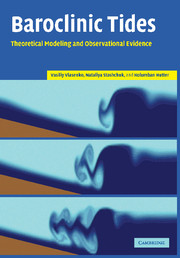Book contents
- Frontmatter
- Contents
- List of tables
- Preface
- Acknowledgements
- List of symbols
- List of abbreviations
- Preamble
- 1 General background
- 2 Linear baroclinic tides over variable bottom topography
- 3 Combined effect of horizontal density gradient and bottom topography on the dynamics of linear baroclinic tides
- 4 Topographic generation of nonlinear baroclinic tides
- 5 Evolutionary stages of baroclinic tides
- 6 Generation mechanism for different background conditions
- 7 Three-dimensional effects of baroclinic tides
- References
- Index
6 - Generation mechanism for different background conditions
Published online by Cambridge University Press: 14 August 2009
- Frontmatter
- Contents
- List of tables
- Preface
- Acknowledgements
- List of symbols
- List of abbreviations
- Preamble
- 1 General background
- 2 Linear baroclinic tides over variable bottom topography
- 3 Combined effect of horizontal density gradient and bottom topography on the dynamics of linear baroclinic tides
- 4 Topographic generation of nonlinear baroclinic tides
- 5 Evolutionary stages of baroclinic tides
- 6 Generation mechanism for different background conditions
- 7 Three-dimensional effects of baroclinic tides
- References
- Index
Summary
The linear wave theory described in Chapters 2 and 3 is useful for interpreting small-amplitude wave phenomena occurring near oceanic bottom features or near density fronts. The nonlinear approach considered in Chapter 4 shows how large the difference can be between the linear and nonlinear waves when the external generating forcing is sufficiently strong. Several examples of the generating processes were studied for both subcritical (Fr < 1) and supercritical (Fr > 1) cases for typical oceanic conditions. However, when considering the large variety of oceanic background stratifications, bottom profiles, or values of external forcings, it is often not possible to apply the results described in Chapter 4 directly to the specific realistic conditions encountered in the field.
In this chapter, we concentrate on phenomena that are new when compared with those described in Chapter 4. These phenomena involve the influence of the vertical and horizontal fluid stratification on the nonlinear mechanism of internal wave generation, as well as the effects related to the rotation of the Earth (especially at high-latitude seas). Nonlinear baroclinic tides over steep bottom topography are also considered. Note that all topics in Chapter 4 were motivated by observational results obtained during field measurements at different sites of the World Ocean. This will also be the approach taken here; thus, all theoretical reasonings will be accompanied by illustrations and interpretations of real in situ data.
- Type
- Chapter
- Information
- Baroclinic TidesTheoretical Modeling and Observational Evidence, pp. 260 - 307Publisher: Cambridge University PressPrint publication year: 2005



